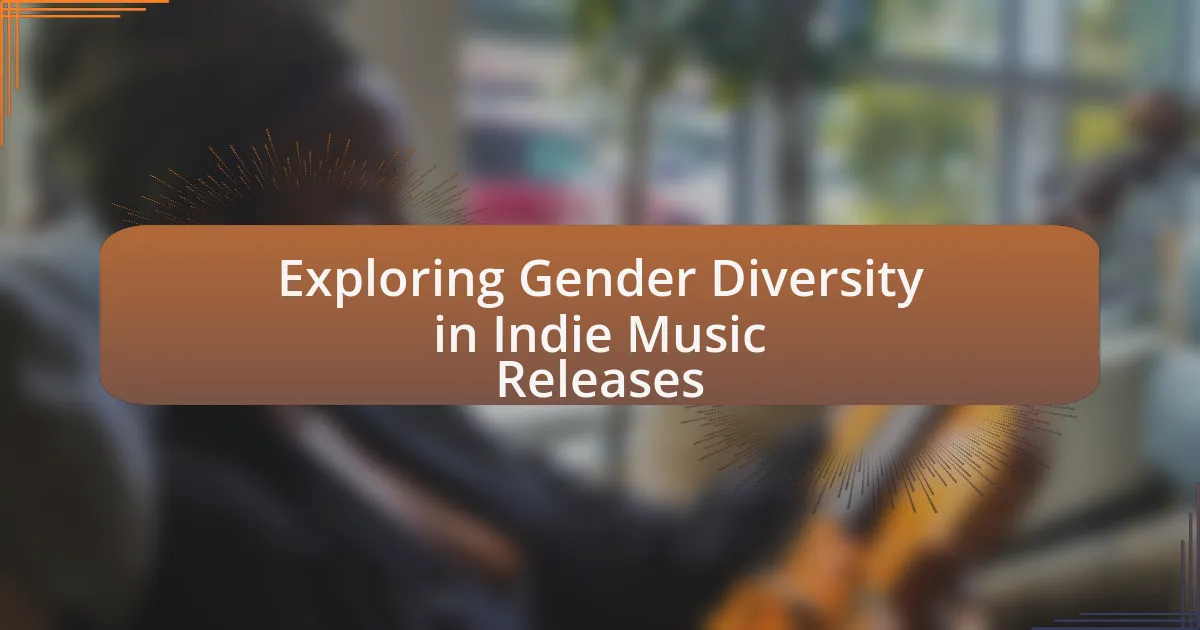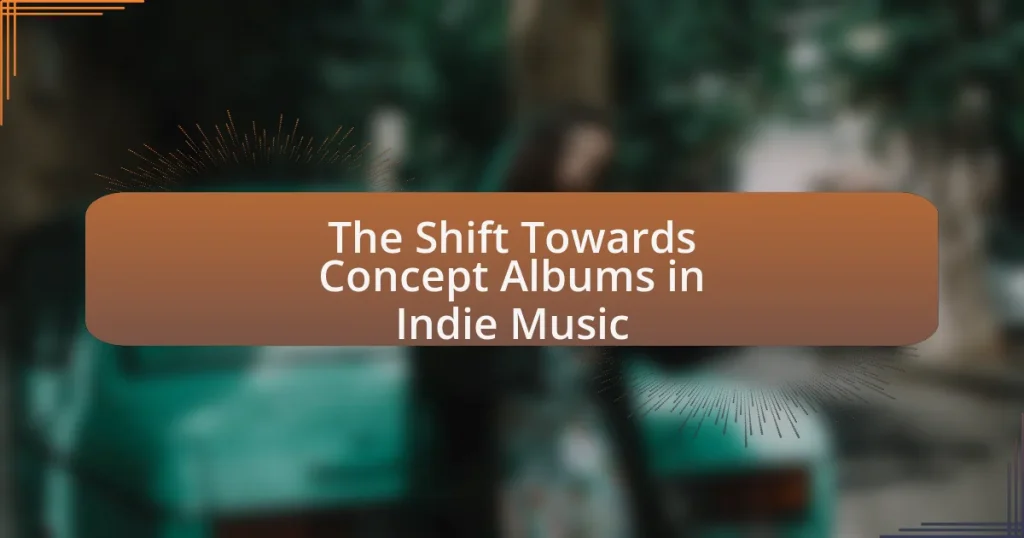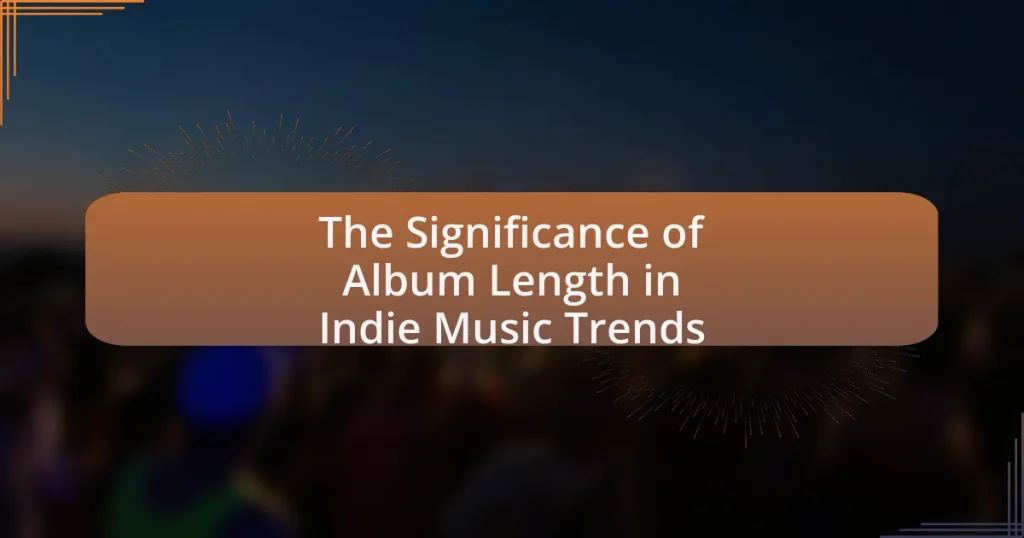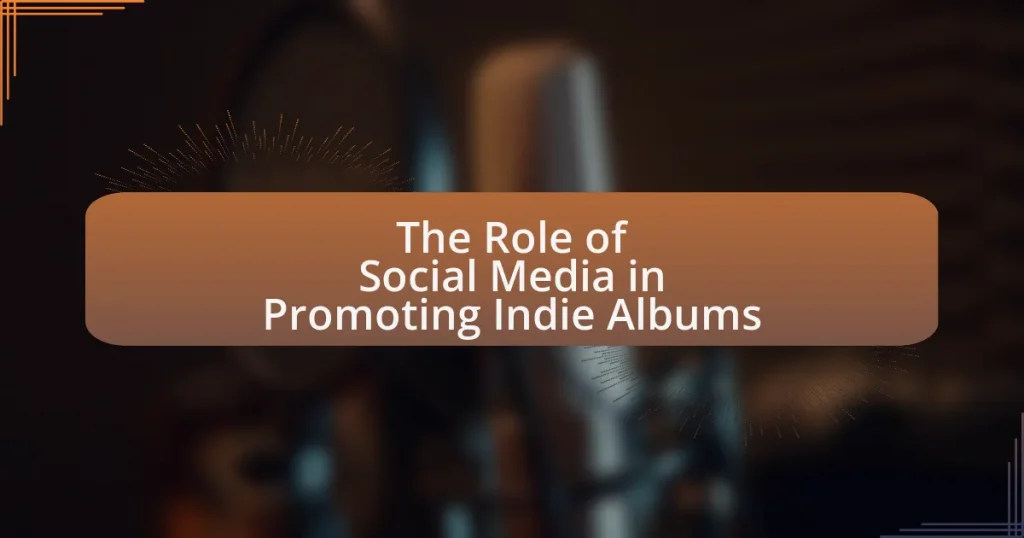Gender diversity in indie music releases refers to the representation of artists across various genders within the independent music scene, highlighting the importance of inclusivity and diverse perspectives. Recent studies indicate a significant rise in female and non-binary artists, with women accounting for approximately 40% of indie music releases in 2022. This article explores the impact of gender diversity on musical creativity, audience engagement, and industry practices, while also addressing the challenges faced by female and non-binary artists. Additionally, it examines current trends, metrics for measuring diversity, and opportunities for promoting equitable representation in the indie music landscape.
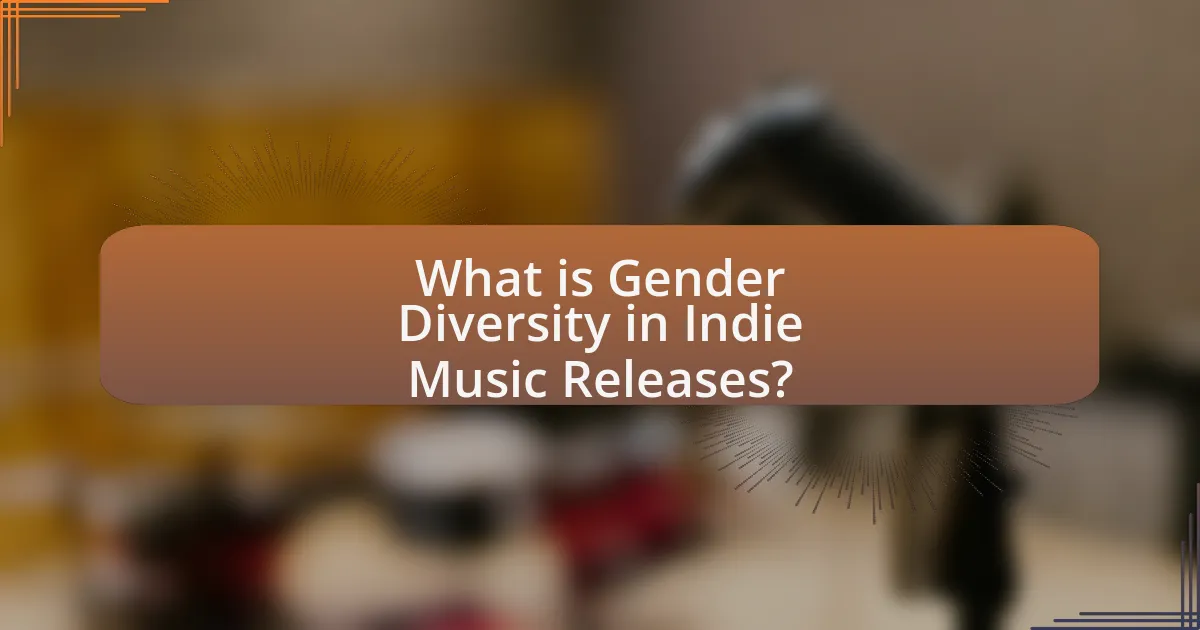
What is Gender Diversity in Indie Music Releases?
Gender diversity in indie music releases refers to the representation and inclusion of artists across different genders within the independent music scene. This diversity is significant as it challenges traditional gender norms and promotes a broader range of perspectives and experiences in music. According to a 2021 study by the Annenberg Inclusion Initiative, women represented only 22.5% of artists in popular music, highlighting the need for increased gender diversity. In the indie music sector, however, there has been a noticeable rise in female and non-binary artists, contributing to a more balanced and inclusive landscape. This shift not only enriches the music itself but also fosters a more equitable industry environment.
Why is Gender Diversity Important in the Indie Music Scene?
Gender diversity is important in the indie music scene because it fosters creativity and innovation, leading to a richer and more varied musical landscape. Diverse perspectives contribute to unique storytelling and artistic expression, which can resonate with a broader audience. Research indicates that gender-diverse teams produce more innovative outcomes; for instance, a study by McKinsey & Company found that companies in the top quartile for gender diversity are 21% more likely to experience above-average profitability. This principle applies to the indie music scene, where varied voices can challenge norms and push boundaries, ultimately enhancing the genre’s evolution and appeal.
How does gender diversity influence musical creativity and expression?
Gender diversity significantly enhances musical creativity and expression by introducing a wider range of perspectives and experiences. Research indicates that diverse teams produce more innovative outcomes; for instance, a study by the National Endowment for the Arts found that gender-diverse groups in music composition lead to unique soundscapes and lyrical themes that resonate with broader audiences. This diversity fosters collaboration, encouraging artists to explore unconventional ideas and challenge traditional norms, ultimately enriching the musical landscape.
What impact does gender diversity have on audience engagement?
Gender diversity positively impacts audience engagement by broadening perspectives and fostering inclusivity. Research indicates that diverse teams produce more innovative ideas, which can resonate with a wider audience. For instance, a study by McKinsey & Company found that companies with higher gender diversity are 21% more likely to experience above-average profitability, suggesting that diverse representation can enhance appeal and connection with varied audience demographics. This connection is crucial in the indie music scene, where authenticity and relatability drive listener loyalty and engagement.
What are the Current Trends in Gender Representation in Indie Music?
Current trends in gender representation in indie music show an increasing visibility of female and non-binary artists. Data from the 2022 Music Industry Report indicates that women accounted for approximately 40% of indie music releases, a significant rise from previous years. Additionally, initiatives like the “Women in Music” campaign have fostered greater inclusivity, encouraging labels to sign diverse talent. This shift is further supported by platforms such as Bandcamp, which highlight female and non-binary musicians, contributing to a more balanced representation in the indie music scene.
How has the representation of female artists evolved in recent years?
The representation of female artists has significantly increased in recent years, particularly within the indie music scene. Data from the 2021 Annenberg Inclusion Initiative revealed that female artists accounted for 40.5% of all artists in popular music, a notable rise from previous years. Additionally, festivals and music platforms have made concerted efforts to feature more female acts, with events like the 2022 Coachella lineup showcasing a record number of female performers. This shift reflects a broader cultural recognition of gender diversity and the importance of equitable representation in the music industry.
What role do non-binary and genderqueer artists play in the indie music landscape?
Non-binary and genderqueer artists play a crucial role in the indie music landscape by challenging traditional gender norms and expanding the representation of diverse identities. These artists contribute unique perspectives and experiences that enrich the genre, fostering inclusivity and encouraging dialogue around gender diversity. For instance, artists like Sam Smith and Janelle Monáe have gained significant recognition, showcasing how non-binary and genderqueer identities can influence musical expression and artistry. Their presence not only broadens the scope of indie music but also inspires a new generation of musicians to embrace their identities, thereby reshaping the cultural narrative within the industry.
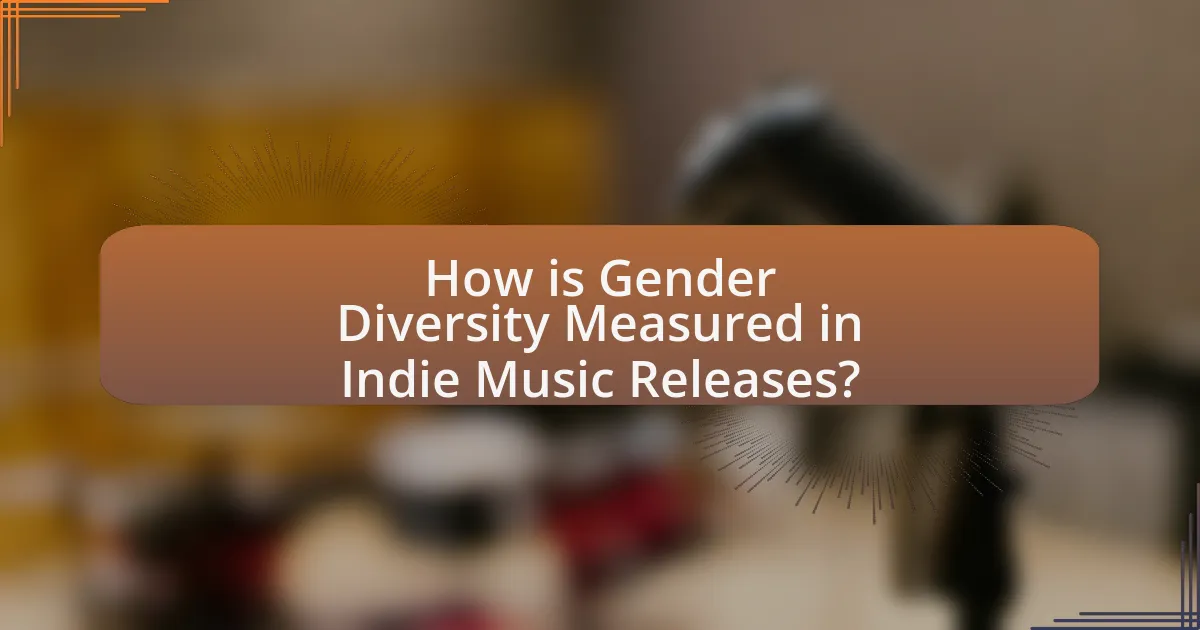
How is Gender Diversity Measured in Indie Music Releases?
Gender diversity in indie music releases is measured primarily through the analysis of the gender of artists involved in the creation and performance of music. This includes evaluating the percentage of female, male, and non-binary artists in released tracks, albums, and performances. Studies, such as those conducted by the Annenberg Inclusion Initiative, have shown that women represent a significantly lower percentage of artists in the music industry, with findings indicating that only about 22% of artists in popular music are female. Additionally, metrics such as the gender breakdown of songwriting credits, production roles, and the presence of female musicians in festival lineups further contribute to understanding gender diversity in indie music.
What metrics are used to assess gender diversity in music releases?
Metrics used to assess gender diversity in music releases include the percentage of female artists, the ratio of male to female artists, and the representation of women in songwriting and production roles. These metrics provide a quantitative analysis of gender representation within the music industry. For instance, a study by the Annenberg Inclusion Initiative found that only 22.5% of artists in popular music were female from 2012 to 2019, highlighting significant gender disparity. Additionally, tracking the number of female-led projects versus male-led projects over time can further illustrate trends in gender diversity within music releases.
How do charts and sales data reflect gender diversity?
Charts and sales data reflect gender diversity by illustrating the representation of male and female artists in music rankings and sales figures. For instance, data from the Billboard charts shows that female artists have historically been underrepresented, with only 22% of the top 100 songs in 2020 featuring female lead artists. This disparity highlights the gender gap in the music industry, where male artists dominate sales and chart positions. Furthermore, sales data from platforms like Spotify and Apple Music often reveal similar trends, indicating that female artists face challenges in gaining equal visibility and commercial success compared to their male counterparts.
What qualitative measures can be used to evaluate gender representation?
Qualitative measures to evaluate gender representation include content analysis, interviews, and focus groups. Content analysis involves examining lyrics, themes, and visual representations in music videos to assess how genders are portrayed. Interviews with artists and industry professionals can provide insights into their experiences and perceptions regarding gender representation in indie music. Focus groups can facilitate discussions among listeners about their interpretations and feelings towards gender representation in music, revealing societal attitudes and biases. These methods collectively offer a comprehensive understanding of gender dynamics within the indie music scene.
How do Industry Practices Affect Gender Diversity in Indie Music?
Industry practices significantly influence gender diversity in indie music by shaping opportunities for female artists and altering perceptions of their contributions. For instance, the predominance of male-led labels and decision-makers often results in a bias towards male artists, limiting the visibility and support for women in the industry. According to a 2021 study by the Annenberg Inclusion Initiative, only 22.5% of artists in the music industry were women, highlighting the disparity created by industry norms. Furthermore, practices such as networking opportunities, festival lineups, and media coverage tend to favor male artists, perpetuating a cycle that hinders gender diversity. This systemic bias in industry practices directly correlates with the underrepresentation of women in indie music, demonstrating the need for more equitable practices to foster inclusivity.
What barriers do female and non-binary artists face in the indie music industry?
Female and non-binary artists face significant barriers in the indie music industry, including gender bias, lack of representation, and limited access to resources. Gender bias manifests in the form of stereotypes that often undervalue their contributions, leading to fewer opportunities for performances and recognition. A study by the Annenberg Inclusion Initiative found that only 22.4% of artists in popular music are women, highlighting the underrepresentation of female artists. Additionally, non-binary artists often encounter challenges related to identity acceptance and visibility, which can hinder their ability to secure gigs and funding. The lack of mentorship and networking opportunities further exacerbates these issues, making it difficult for them to navigate the industry effectively.
How can record labels and promoters support gender diversity?
Record labels and promoters can support gender diversity by actively prioritizing and promoting female and non-binary artists in their rosters and marketing strategies. This can be achieved through initiatives such as equitable hiring practices, ensuring diverse representation in decision-making roles, and creating platforms specifically for underrepresented artists. For instance, a study by the Annenberg Inclusion Initiative found that women comprised only 21.7% of artists across the top 600 songs in 2019, highlighting the need for targeted efforts to increase visibility and opportunities for these groups. By implementing mentorship programs and partnerships with organizations focused on gender equality in music, record labels and promoters can further enhance their commitment to fostering a more inclusive industry.
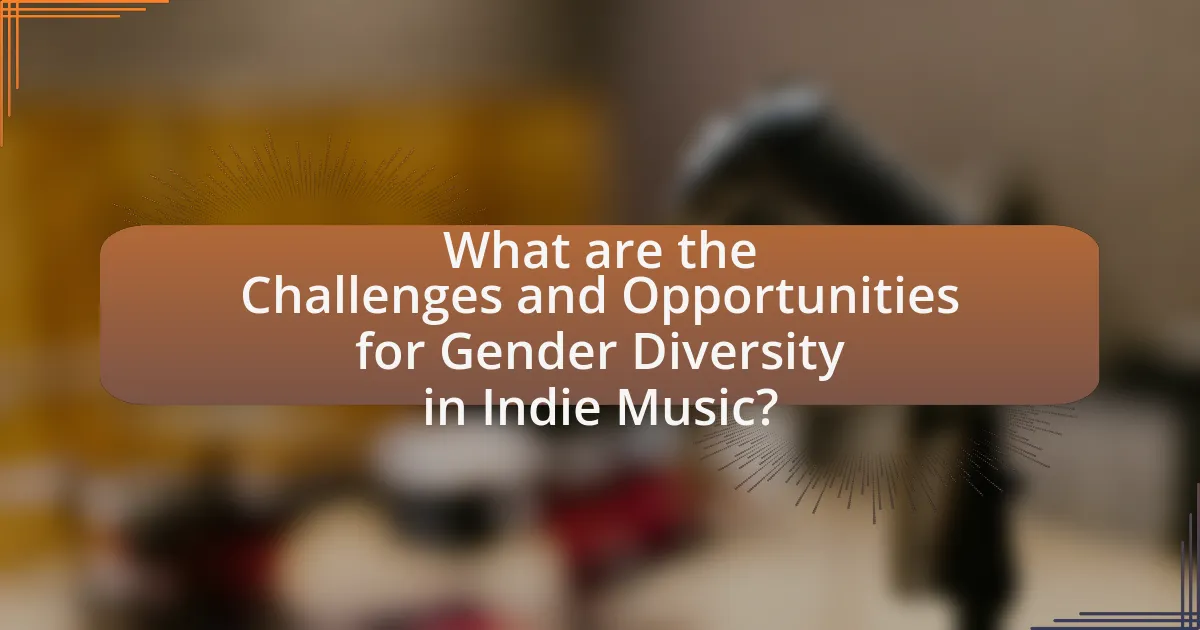
What are the Challenges and Opportunities for Gender Diversity in Indie Music?
The challenges for gender diversity in indie music include systemic biases, limited access to resources, and underrepresentation in industry decision-making roles. These barriers often result in fewer opportunities for female artists and marginalized genders to gain visibility and support. Conversely, opportunities for gender diversity arise from the growing demand for inclusive representation and the rise of platforms that promote diverse voices, such as social media and independent labels. Research indicates that diverse teams in music production lead to more innovative and commercially successful outcomes, highlighting the potential benefits of fostering gender diversity in the indie music scene.
What challenges do artists encounter in achieving gender diversity?
Artists encounter several challenges in achieving gender diversity, primarily due to systemic biases and industry barriers. These challenges include unequal access to resources, representation in decision-making roles, and societal stereotypes that influence audience perceptions. For instance, a study by the Annenberg Inclusion Initiative found that only 22.4% of artists in popular music were women, highlighting the significant gender disparity in the industry. Additionally, women often face difficulties in securing funding and support for their projects, which further limits their visibility and opportunities in the indie music scene.
How does societal perception influence the success of diverse artists?
Societal perception significantly influences the success of diverse artists by shaping audience acceptance and market opportunities. When society embraces diversity, artists from varied backgrounds often experience increased visibility and support, leading to higher sales and streaming numbers. For instance, a study by the University of Southern California’s Annenberg Inclusion Initiative found that music artists from underrepresented groups who received positive media coverage were more likely to achieve commercial success. This correlation indicates that societal attitudes can directly impact the financial viability and recognition of diverse artists in the music industry.
What are the financial implications of gender diversity in music releases?
Gender diversity in music releases has significant financial implications, as studies indicate that diverse teams can lead to increased revenue and market reach. For instance, a report by the Annenberg Inclusion Initiative found that songs featuring female artists generated higher streaming numbers and sales, demonstrating that gender diversity can enhance commercial success. Additionally, the presence of women in music production roles has been linked to a broader appeal, attracting diverse audiences and ultimately driving higher profits. This evidence underscores the financial benefits of promoting gender diversity within the music industry.
What opportunities exist for promoting Gender Diversity in Indie Music?
Opportunities for promoting gender diversity in indie music include creating platforms that specifically showcase female and non-binary artists, increasing representation in music festivals, and implementing mentorship programs. Research indicates that female artists are underrepresented in the music industry, with only 22% of artists in the Billboard Hot 100 being women in 2020. By establishing initiatives like all-female lineups or gender-balanced panels, the indie music scene can actively support and elevate diverse voices. Additionally, organizations such as She Is The Music and Girls Who Code in Music are working to provide resources and networking opportunities for women in the industry, further enhancing gender diversity.
How can festivals and events enhance gender representation?
Festivals and events can enhance gender representation by actively promoting diverse lineups and creating inclusive spaces for all genders. By featuring a balanced mix of male, female, and non-binary artists, festivals can challenge traditional gender norms in the music industry. For instance, research by the Annenberg Inclusion Initiative found that only 22.5% of artists in popular music were women from 2012 to 2019, highlighting the need for initiatives that prioritize gender diversity. Additionally, events that implement mentorship programs and workshops for underrepresented genders can empower emerging artists, fostering a more equitable music scene.
What role do social media and digital platforms play in promoting diverse voices?
Social media and digital platforms play a crucial role in promoting diverse voices by providing accessible channels for underrepresented artists to share their work and connect with audiences. These platforms enable marginalized groups, including women and non-binary individuals in the indie music scene, to bypass traditional gatekeepers like record labels and radio stations, thus amplifying their visibility. For instance, a study by the Annenberg Inclusion Initiative found that women comprised only 21.6% of artists in popular music, highlighting the need for platforms that support gender diversity. Social media allows these artists to build communities, engage with fans directly, and collaborate with others, fostering a more inclusive music landscape.
What Best Practices Can Support Gender Diversity in Indie Music?
Best practices that can support gender diversity in indie music include implementing equitable hiring practices, promoting female and non-binary artists through dedicated platforms, and fostering inclusive environments within music communities. Research indicates that diverse teams lead to more innovative outcomes; for instance, a study by McKinsey & Company found that companies in the top quartile for gender diversity are 21% more likely to outperform on profitability. Additionally, initiatives like mentorship programs for underrepresented artists can enhance visibility and opportunities, as evidenced by organizations such as Girls Who Code, which has successfully increased female participation in tech fields, paralleling efforts needed in music.
How can artists collaborate to promote gender diversity?
Artists can collaborate to promote gender diversity by creating joint projects that feature diverse voices and perspectives. For instance, they can co-write songs, produce albums, or organize concerts that highlight female and non-binary artists, thereby amplifying underrepresented narratives in the music industry. Research indicates that collaborative efforts in music not only enhance creativity but also foster inclusivity, as seen in initiatives like the “Women in Music” organization, which supports female artists through networking and mentorship. By actively engaging in such collaborations, artists can challenge gender norms and contribute to a more equitable music landscape.
What strategies can fans adopt to support diverse indie music artists?
Fans can adopt several strategies to support diverse indie music artists, including actively promoting their music on social media platforms, attending live performances, and purchasing their merchandise. By sharing artists’ work on platforms like Instagram and Twitter, fans increase visibility and reach, which can lead to greater opportunities for the artists. Attending live shows not only provides financial support but also fosters a sense of community around the artist’s work. Additionally, buying merchandise directly from artists ensures that a larger portion of the revenue goes to them, which is crucial for indie musicians who often rely on these sales for their livelihood. These actions collectively contribute to a more inclusive music industry, as they help elevate underrepresented voices and promote gender diversity within the indie music scene.
